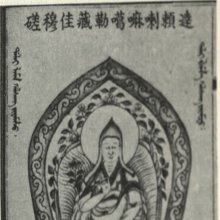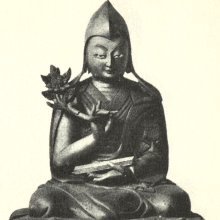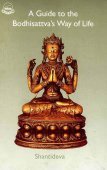Dalai Lama: 2 definitions
Introduction:
Dalai Lama means something in Buddhism, Pali. If you want to know the exact meaning, history, etymology or English translation of this term then check out the descriptions on this page. Add your comment or reference to a book if you want to contribute to this summary article.
Images (photo gallery)
In Buddhism
General definition (in Buddhism)
Source: WikiPedia: BuddhismThe Dalai Lama is a lineage of religious leaders of the Gelug school of Tibetan Buddhism and was the political leader of Lhasa based Tibetan government between the 17th century and 1959. Referred to by his followers simply as "His Holiness" (HH), or "His Holiness The Dalai Lama", many Tibetans usually call the Dalai Lama by the epithets Gyalwa Rinpoche, meaning "Precious Victor", or Yishin Norbu, meaning "Wish fulfilling Jewel." "Lama" (meaning "teacher") is a title given to many different ranks of Tibetan Buddhist clergy.
The Dalai Lama is believed to be the current incarnation of a long line of Tulkus, or Buddhist Masters, who have become exempt from the wheel of death and rebirth. These ascended masters have chosen of their own free will to be reborn to this place in order to enlighten others. He is also the official leader of the Tibetan government in exile, or the Central Tibetan Administration (CTA).
Source: Shambala Publications: GeneralDalai Lama (dalai bla-ma), Mong. and Tib., lit., “teacher whose wisdom is as great as the ocean”; an honorary title bestowed by the Mongolian prince Altan Khan on the third head of the Geluk school in 1578. This close connection with Mongolia brought the school of Tsongkhapa into a position of political preeminence, which with the fifth Dalai Lama (1617–82) was consolidated into rulership over all of Tibet. Since this time, the Dalai Lama has been regarded as an incarnation of Avalokiteshvara, and the Panchen Lama has been venerated as his spiritual representative. Each Dalai Lama is considered a reincarnation (tulku) of the preceding Dalai Lamas.
The Dalai Lamas not only fulfilled their role as heads of state. Among them are also great scholars and poets filled with joie de vivre, like the sixth Dalai Lama. The fourteenth Dalai Lama, in exile since 1959, combines in his person a spiritual and political authority that is still binding for the Tibetan people.
The individual Dalai Lamas are as follows:
- Dalai Lama Gendün Drub (1391–1475)
- Dalai Lama Gendün Gyatso (1475–1542)
- Dalai Lama Sönam Gyatso (1543–1588)
- Dalai Lama Yönten Gyatso (1589–1617)
- Dalai Lama Losang Gyatso (1617–1682)
- Dalai Lama Jamyang Gyatso (1683–1706)
- Dalai Lama Kelsang Gyatso (1708–1757)
- Dalai Lama Jampel Gyatso (1758–1804)
- Dalai Lama Lungtog Gyatso (1806–1815)
- Dalai Lama Tsültrim Gyatso (1816–1837)
- Dalai Lama Kedrub Gyatso (1838–1856)
- Dalai Lama Trinle Gyatso (1856–1875)
- Dalai Lama Tubten Gyatso (1876–1933)
- Dalai Lama Tenzin Gyatso (born 1935)
See also (Relevant definitions)
Partial matches: Lama, Dalai, Talai.
Full-text: Ganden Tripa, Mantrayana, Potala, Gelug, Kalacakra, Pundarika, Avalokiteshvara, Vajrabhairava, Narthang, Peking, Pravrittivishaya, Vibhava-tanha, Bon.
Relevant text
Search found 21 books and stories containing Dalai Lama; (plurals include: Dalai Lamas). You can also click to the full overview containing English textual excerpts. Below are direct links for the most relevant articles:
A Blessed Pilgrimage (by Dr. Yutang Lin)
Tibet (Myth, Religion and History) (by Tsewang Gyalpo Arya)
5. Buddhist Schools and the Politics of Tibet < [Chapter 7 - Buddhism in Tibet]
10. Conclusion < [Chapter 7 - Buddhism in Tibet]
8. The Three Yanas < [Chapter 7 - Buddhism in Tibet]
The Way of the White Clouds (by Anāgarika Lāma Govinda)
Chapter 37 - The State Oracle of Nāchung < [Part 3 - Death and Rebirth]
Chapter 35 - Lengthening Shadows < [Part 3 - Death and Rebirth]
Chapter 24 - The Guru's Passing Away < [Part 3 - Death and Rebirth]
Socially Engaged Buddhism (with reference to Australian society) (by Phuong Thi Thu Ngo)
B (3). Economic ideal in the Time of Buddha < [Chapter 5]
Buddhist and Its Developed Period in Australia < [Chapter 3]
A (1-2). Education of the Adult and Children Public < [Chapter 5]
The gods of northern Buddhism (by Alice Getty)
Part III - The Expansion Of Buddhism < [Introduction]
Part IV - The Religious Community (sangha) < [Introduction]
Buddhist Meditation (by Samdhong Rinpoche)
Related products


